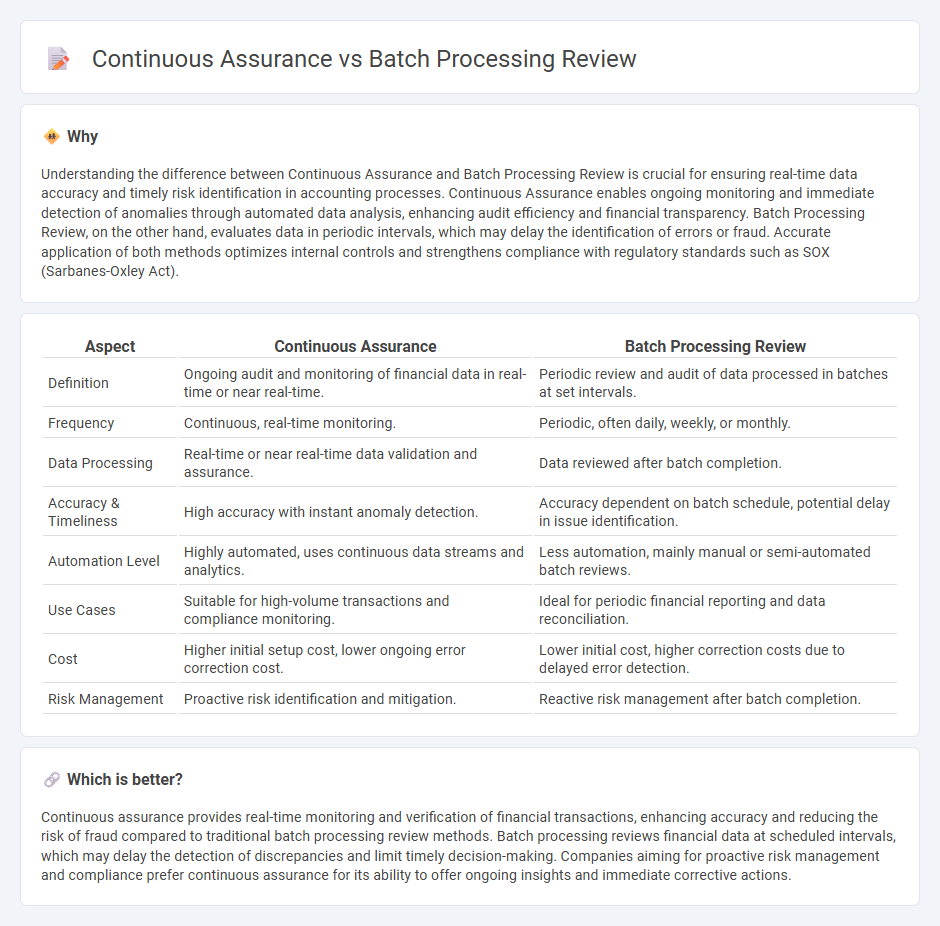
Continuous assurance provides real-time financial data verification by integrating automated controls and analytics within transactional systems, enhancing accuracy and timeliness in accounting processes. Batch processing, in contrast, accumulates data over a period before executing processing tasks, often leading to time delays and reduced immediacy in error detection. Explore comprehensive insights to understand how these methodologies impact financial reporting and compliance.
Why it is important
Understanding the difference between Continuous Assurance and Batch Processing Review is crucial for ensuring real-time data accuracy and timely risk identification in accounting processes. Continuous Assurance enables ongoing monitoring and immediate detection of anomalies through automated data analysis, enhancing audit efficiency and financial transparency. Batch Processing Review, on the other hand, evaluates data in periodic intervals, which may delay the identification of errors or fraud. Accurate application of both methods optimizes internal controls and strengthens compliance with regulatory standards such as SOX (Sarbanes-Oxley Act).
Comparison Table
| Aspect | Continuous Assurance | Batch Processing Review |
|---|---|---|
| Definition | Ongoing audit and monitoring of financial data in real-time or near real-time. | Periodic review and audit of data processed in batches at set intervals. |
| Frequency | Continuous, real-time monitoring. | Periodic, often daily, weekly, or monthly. |
| Data Processing | Real-time or near real-time data validation and assurance. | Data reviewed after batch completion. |
| Accuracy & Timeliness | High accuracy with instant anomaly detection. | Accuracy dependent on batch schedule, potential delay in issue identification. |
| Automation Level | Highly automated, uses continuous data streams and analytics. | Less automation, mainly manual or semi-automated batch reviews. |
| Use Cases | Suitable for high-volume transactions and compliance monitoring. | Ideal for periodic financial reporting and data reconciliation. |
| Cost | Higher initial setup cost, lower ongoing error correction cost. | Lower initial cost, higher correction costs due to delayed error detection. |
| Risk Management | Proactive risk identification and mitigation. | Reactive risk management after batch completion. |
Which is better?
Continuous assurance provides real-time monitoring and verification of financial transactions, enhancing accuracy and reducing the risk of fraud compared to traditional batch processing review methods. Batch processing reviews financial data at scheduled intervals, which may delay the detection of discrepancies and limit timely decision-making. Companies aiming for proactive risk management and compliance prefer continuous assurance for its ability to offer ongoing insights and immediate corrective actions.
Connection
Continuous assurance enhances accounting accuracy by providing real-time transaction monitoring, while batch processing review aggregates financial data at set intervals to identify discrepancies. The integration of continuous assurance with batch processing review improves audit efficiency by enabling timely detection of irregularities and fostering comprehensive financial reporting. This connection supports robust internal controls and aligns with regulatory compliance requirements in accounting.
Key Terms
Transaction Timing
Batch processing reviews transactions in accumulated groups at specific intervals, resulting in delayed identification of errors or fraud. Continuous assurance employs real-time monitoring and analysis, allowing immediate detection and correction of transaction discrepancies. Explore how continuous assurance enhances transaction timing and improves audit effectiveness in dynamic environments.
Error Detection
Batch processing review identifies errors by analyzing data sets after transaction periods, often resulting in delayed detection and correction of discrepancies. Continuous assurance leverages real-time monitoring and automated controls, enabling immediate identification and resolution of anomalies to enhance accuracy and reliability. Explore the advantages of continuous assurance in error detection for efficient financial and operational management.
Audit Frequency
Batch processing review typically involves evaluating financial data at specific intervals, such as monthly or quarterly, creating a lag between transactions and audits. Continuous assurance leverages real-time data monitoring and analytics to provide ongoing audit feedback, enhancing error detection and risk management. Discover how shifting from periodic to continuous audit frequency can transform organizational compliance and accuracy.
Source and External Links
What is batch processing? (Advantages and disadvantages) - Indeed - Batch processing improves data quality by automating error detection, efficiently uses computer systems during low demand periods, supports offline operation without disrupting daily tasks, and enhances overall operational efficiency through scheduled job execution.
What Is Batch Data Processing? Advantages Against Real Time - Batch processing is cost-effective, scalable, reliable, and allows thorough data accuracy checks by scheduling jobs during off-peak times, making it simpler and more efficient than real-time processing for many data workflows.
What is Batch Processing? - AWS - Batch processing involves periodically handling large volumes of repetitive data jobs in off-peak times, reducing system strain and requiring minimal human supervision while ensuring tasks like reporting and data updates are efficiently completed.
 dowidth.com
dowidth.com